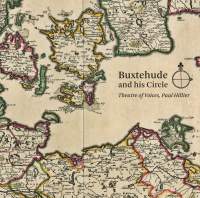Texte paru dans: / Appeared in: |
|
|
Outil de traduction ~ (Très approximatif) |
|
|
Reviewer: James
A. Altena As the title of this CD indicates, the works featured here are all by German composers with nearer or farther degrees of relation—one decidedly far—to Diderich Buxtehude. The connection with Franz Tunder (1614–1667) was familial and chronological but not personal; Buxtehude succeeded Tunder as organist of the Marienkirche in Lübeck, and married Tunder’s daughter as one of the attendant conditions, but the two men apparently never met. Nicolaus Bruhns (1665–1697) was perhaps Buxtehude’s most esteemed pupil. The uncle of Nicholas, Peter Bruhns, was Buxtehude’s violinist for many years. Kaspar Förster (1616–1673), about whom relatively little is known save that he variously made his career as a composer and bass vocalist in Warsaw, Danzig, and Copenhagen, was one of Buxtehude’s teachers in Copenhagen for a period of time between 1652 and 1657. The connection of Christian Geist (c. 1650–1711) to Buxtehude is far more tenuous. The son of a cathedral cantor, Geist was born in Güstrow, near the port city of Rostock in northeastern Germany. As an adolescent he was a member of the ducal court orchestra in Mecklenberg; records then place him first as a bass singer to the Danish royal court in Copenhagen in 1669, and then as an assistant to the noted organist Gustav Düben the Elder (1628–1690) in Stockholm from 1670 to 1679. After that he became organist of the German church in the Swedish port of Gothenburg, and then in 1684 he became organist of the Helligåndskirken (Church of the Holy Ghost) in Copenhagen—a position to which he acceded by marrying the widow of his predecessor, Johann Martin Radeck (c. 1623–1684), who for his part in 1668 had previously succeeded Buxtehude as organist of the Mariae-Kirke in Helsingør (Elsinore of Hamlet fame). Geist also served as organist in that city of the Trinitatis-Kirke (Church of the Holy Trinity) and of the Holmens-Kirke (Holmens Church, where Niels Gade later was buried). He, his wife, and all their children fell victims to a bout of the bubonic plague; his surviving musical corpus consists of about 60 sacred vocal works and a couple of organ pieces of disputed authenticity. His putative connection to Buxtehude is twofold in nature. First, Düben, an indefatigable scribe who is our sole source for many surviving pieces of Baroque music, copied out the vast majority of the known works of Buxtehude’s oeuvre, and so Geist was likely acquainted with them. Second, one of Geist’s predecessors at the Holmens-Kirke was Johann Lorentz the Younger (c. 1610–1689), who according to musicologist André Pirro was one of Buxtehude’s teachers, though it is equally possible that it could have been instead Johann Lorentz the Elder (c. 1580–1650). However far-fetched the rationales for bringing these composers together on one CD, their compositions are stylistically all of a piece with one another and make for a splendid recital. And there are few artists as well equipped to perform this repertoire than Paul Hillier and his Theatre of Voices ensemble, here consisting of seven vocalists (two sopranos and two tenors, plus a mezzo-soprano, countertenor, and bass) and eight instrumentalists (two violins and two violas, plus a cello, violone, bassoon, and organ). All the pieces but one (the Bruhns, for solo bass voice) feature three to five vocal soloists, supported by the instrumental ensemble. The singing and playing are superb in every way: technically secure and polished, bold, confident, colorful, expressive. The recorded sound is excellent, and the booklet provides notes in English, German, and Danish, plus vocal texts in the original German or Latin with English translations. Finally, as an extra treat, the booklet cover and the CD feature a gloriously detailed color reproduction of a 16th- or 17th-century Danish map of the Baltic region. (Have a magnifying glass handy to make out all the details!) This disc is an unalloyed treat that belongs in every collection of early Baroque sacred vocal music; enthusiastically recommended. | |
|
|
|
|
Cliquez l'un ou l'autre
bouton pour découvrir bien d'autres critiques de CD |
|




